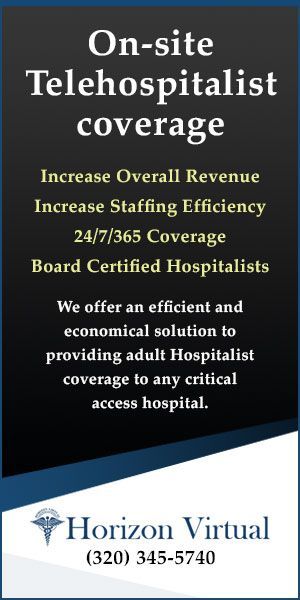Capsules
Minneapolis VA Opens New Education/Training Center
The Minneapolis VA Medical Center recently hosted a ribbon cutting ceremony opening the new Interprofessional Education and Collaboration Center (IPECC). The 1500-square-foot state-of-the-art facility is designed to provide a dynamic learning environment where VA staff and health profession trainees can come together to learn, share knowledge and collaborate on best practices. “We are thrilled to open the doors of the IPECC and host health care professionals from all disciplines in a variety of learner-centric simulation lab, multipurpose classroom and computer lab settings,” said Ezgi Tiryaki, MD, associate chief of staff for education. “Access to professional development in proximity to clinical care spaces is critical for providing veteran-centric care.” The IPECC includes an extensive array of innovative simulation education capabilities. With the mission of promoting veteran patient safety through simulation education and a focus on improving communications and teamwork, the IPECC will have several capabilities including:
- Simulation of adult and pediatric emergencies.
- Simulation of women’s health services.
- Simulation of hospital environments using state-of-the-art devices.
Learners will include residents, medical students, nurses, attending physicians, military medical personnel, respiratory therapists, anesthesiologists, dentists, radiologists, pharmacists and laboratory personnel as well as other health care professionals. Through the use of science-based curriculum and scenario development, the IPECC provides an environment for learning reinforced by using audio and visual recording. Students will improve their skills and abilities via objective debriefing sessions with trained clinical simulation instructors. The facility includes a tele-ICU simulation lab, a two-bed nursing patient simulation lab and the fundamentals of laparoscopic surgery (FLS) testing center. Housed within the existing Minneapolis VA Medical Center, the IPECC will be used as headquarters for training nearly 3,000 Minneapolis VA health care providers on a new electronic records system.
Avera Announces $245 Million New Facilities Plan
Avera recently announced plans to build a six-story tower addition to Avera McKennan Hospital & University Health Center and a three-story building on the Avera on Louise Health Campus. Combined, this marks the largest new construction project in Avera’s history with a projected cost of $245 million. At 350,000 square feet, it will be the largest expansion ever of a hospital patient care space in Sioux Falls. “This project is important to all of Avera’s 300 locations. Our tertiary hospital is foundational to the quality of care we’re able to deliver as an interconnected system. Years of planning and research have gone into evidence-based care for the population we serve, and I’m confident this project will benefit patients for generations to come,” said Jim Dover, FACHE, Avera president and CEO. The tower will create a new main entrance for Avera McKennan as well as a specialized center for women’s and children’s hospital services, including labor and delivery, postpartum care, newborn nursery, neonatal intensive care unit, pediatric hospital care and pediatric intensive care. Adding a total of 158 beds, the project will accommodate current and future population growth and increased demand for medical services. The Sioux Falls metropolitan statistical area (MSA) population is projected to increase by more than 100,000 in the next 15 years. Avera McKennan currently provides 42,000 inpatient and 1.1 million hospital outpatient visits each year, serving a radius of 300 miles. It’s a hub for specialty referral and tertiary care from 36 Avera hospitals and 200 clinics across a 72,000-square-mile footprint, serving a population of 1 million. “Avera has three core values of compassion, hospitality and stewardship. In line with our value of hospitality, our new tower will create a welcoming front door to our hospital,” said Ronald Place, MD, regional president and CEO of Avera McKennan. At the Avera on Louise Health Campus, Avera will build a three-story building for digestive health services. Construction is expected to begin in mid- to late summer at both campuses. Estimated completion date is early 2026 for the Avera on Louise project and early 2027 for the main hospital campus project.
Minnesota Indian Area Agency on Aging Expands Coverage
Starting in July 2024, the Minnesota Indian Area Agency (MIAA) will expand its coverage from four of the 11 statewide tribal nations. Planning and service areas will change to better serve American Indian elders in 10 of the 11 tribal nations that share geographic area with Minnesota. The changes are happening after several years of consultation with tribal leaders seeking a better way to meet the needs of their elders. The reorganized Minnesota Indian Area Agency on Aging will support the development of culturally significant and appropriate resources for elders, with services administered and run by tribal governments. The result will be more and better services and programs for tribal elders. The new resources will help close the wide disparities for Native American elders in all areas of aging needs, particularly in-home and social services. “We believe these changes will improve the lives of Indigenous elders living in Minnesota,” said Maureen Schneider, interim chair of the Minnesota Board on Aging. “Tribal leadership collaborated with us on this reorganization to better serve their people.” Established by the Minnesota Board on Aging in 1980, the Minnesota Indian Area Agency on Aging was originally administered by the Minnesota Chippewa Tribe and served the Bois Forte Band of Chippewa, Grand Portage Band of Lake Superior Chippewa, Leech Lake Band of Ojibwe and the White Earth Nation. The reorganized agency will continue to serve the original four tribal communities, as well as the Lower Sioux Indian Community, Mille Lacs Band of Ojibwe, Prairie Island Indian Community, Red Lake Nation, Upper Sioux Community and Fond du Lac Band of Lake Superior Chippewa. The Minnesota Board on Aging is federally designated to administer Older Americans Act funds in Minnesota. The board designates Area Agencies on Aging, regional organizations that fund local service providers to connect older adults and their families to services, supports and information. Services include nutrition, household chores, caregiver support, health promotion, homemaker and transportation that help older adults live well, age well. Minnesota has seven Area Agencies on Aging that connect older Minnesotans to the community support they need as they age.
Blue Cross Releases 2023 Financial Report
Blue Cross and Blue Shield of Minnesota (Blue Cross) recently released a summary of financial results from 2023. It reported $15.3 billion in total revenue and an operating margin of less than 1 percent ($103.7 million). “I am pleased with our financial performance for 2023, as our results underscore our proven capabilities to operate as a responsible and sustainable health organization across increasingly competitive markets,” said Dana Erickson, president and CEO of Blue Cross and Blue Shield of Minnesota. “In a year marked by higher-than-average utilization of health care services, we were still able to advance numerous initiatives tied to our key goals of expanded access and affordability and maintain our overall top market share. Our modest margins allow for the continued reinvestment in infrastructure and capabilities designed to serve all of our members and communities.” Operating under a complex business structure involving multiple entities, the report cites a total of $13.8 billion in medical claim payments, with approximately 90 cents of every premium dollar going directly to cover members’ health care costs. Additionally, the organization paid more than $63 million in taxes, assessments and surcharges. Total member enrollment for the year ended at approximately 2.5 million. Toward its goal of advancing racial and health equity, in 2023 Blue Cross provided $16.5 million in community investments. Some specific community grants and funding included:
- $6 million for communities to advance racial and health equity through increased access to healthy food and efforts to eliminate commercial tobacco use.
- $4.6 million to increase access to health care coverage and culturally informed care; support early childhood care and education; and strengthen community connections to reduce social isolation.
- $5 million in racial and health equity initiatives, including community funding to 89 organizations.
In addition, Blue Cross supported the achievement of many statewide milestones, including expanded eligibility to MNCare to undocumented residents and universal school meals for all students.
UCare Partners with Violet to Advance Health Equity
UCare has recently announced a partnership with Violet, a pioneering cultural competence insights organization. Their work together will foster inclusive health care delivery and improve health outcomes across the state. Violet created the first-ever standardization and infrastructure for inclusive care. Offering data-driven interventions, from benchmarking providers’ cultural competence to personalized educational pathways, their model makes it easier for patients to find the right providers. By 2045, half of all Americans will have at least one or more diverse identities, including race, sexual orientation, gender identity and more. This partnership marks a significant step forward in advancing health equity initiatives within the health care industry. Key tenets of this collaboration include:
- Inclusive care delivery as a learnable skill: By recognizing the nuances of diverse communities and identities, health care providers and participating UCare staff will be able to better address the unique needs of every single patient.
- Educating providers on health disparities and clinical quality best practices: Educational resources and training modules focused on health disparities and best practices for inclusive care delivery will equip providers with the knowledge and tools to foster a more inclusive and responsive health care environment.
- Improving health outcomes through identity-centered care matching. By connecting patients with culturally competent providers, this initiative seeks to reduce disparities in health care access and improve overall health outcomes for underserved communities.
- “We are thrilled to partner with Violet to promote our shared mission of advancing health equity in Minnesota,” said Pleasant Radford Jr., health equity officer at UCare. “Violet’s equity-centered, community-specific courses offer tools for our clinicians and non-clinical staff to learn, ask questions about what works or doesn’t work, for whom and why and identify new ways to provide inclusive care for our members.”
“We are excited to collaborate with UCare,” said Gaurang Choksi, founder & CEO at Violet. “Together, we can make a profound impact on health outcomes and ensure that every individual receives the care they deserve, regardless of their background or circumstances. And, as someone that grew up on Medicaid, partnering with UCare is extra personal and special to me – especially knowing that we’ll enable thousands of families on Medicaid to access inclusive, in-network care.”
Minnesota Attorney General Urges Improved Cyberattack Response
Minnesota Attorney General Keith Ellison, as part of a bipartisan, multistate coalition of 22 attorneys general, recently sent a letter to UnitedHealth Group, urging more meaningful action in response to the cyberattack. Providers, pharmacies and care facilities have reported catastrophic business disruptions. These have included inability to verify coverage or obtain prior authorization and inability to process claims or obtain reimbursements. Patients report delayed or denied access to prescription drugs and difficulty scheduling appointments or procedures. “As attorney general, it is my job to help Minnesotans afford their lives and live with dignity, safety, and respect,” said Attorney General Ellison. “That includes making sure that patients and providers aren’t left holding the bag when a too-big-to-fail health care conglomerate does indeed fail. It is past time for UnitedHealth Group to use its considerable resources to make providers and patients whole after the catastrophic failure of its system.”
Action steps called for in the letter included:
- Enhanced and expanded financial assistance, free of onerous terms, to all affected providers, facilities and pharmacies.
- Ensuring financial assistance is not more advantageous to entities owned by UnitedHealth Group.
- Suspending requirements for prior authorizations, contemporaneous notifications of change of status and other documentation requirements.
- Providing a dedicated help line for providers, facilities, and pharmacies, and state attorneys general.
- Proactively informing providers, facilities, pharmacies and industry groups on how to preserve claims and receive prompt reimbursement.
- Expeditiously resolving the claims backlog and ensure prompt reimbursement of claims.
Two years ago Attorney General Ellison was part of a group suing to block the UnitedHealth acquisition of Change Healthcare, arguing it would put too much market power and data in the hands of one corporation at so many levels of the health care industry. Following a two-week trial in the District of Columbia, the challenge was denied and the merger allowed to proceed. UnitedHealth Group reported $22 billion in profits in 2023. Even with the February cyberattack, in its first quarter UnitedHealth Group reported revenue of $99.8 billion, up $7.9 billion from same period the previous year. In contrast, many hospitals and clinics are operating under tremendous financial strain, relying on Change Healthcare or adjacent vendors to maintain the operations that support their patient care.
MORE STORIES IN THIS ISSUE
cover story one
Hospital at Home: Inside a growing trend
By David W. Plocher, MD
cover story two
Community First Services and Supports: A New Model for Personal Care Support















